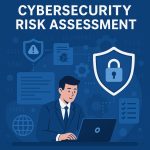Cybersecurity Training for Employees Matters: How to Build a Resilient Team
When you think of cybersecurity, what comes to mind? Firewalls, antivirus software, or complex security systems? While these tools are essential, the truth is that even the most advanced technology can’t protect your business without a well-trained team behind it. That’s why cybersecurity training for employees matters. It turns your people into your first and strongest line of defence.
Cybercriminals today often look for the easiest way in, and that’s rarely through a firewall. It’s through people. Whether it’s a convincing email from a “supplier” or a fake login page that looks legitimate, attackers know how to manipulate human behaviour. Without the right training, employees can unknowingly open the door to data breaches, financial loss, and serious reputational damage.
If you read our earlier article on Employee Security Awareness, you’ll know that awareness is the foundation of a secure workplace. Cybersecurity training builds on that foundation, turning awareness into action. It helps employees not just recognise threats, but respond to them with confidence.
This article explores why cybersecurity training is essential, what topics it should cover, and how to make it effective in your business.
Why Cybersecurity Training is Essential
Cybersecurity tools are powerful, but they can’t stop someone from clicking on a malicious link, sharing sensitive information in an unverified email, or using the same weak password for multiple accounts. These small, everyday actions are where many cyber incidents begin.
Training closes that gap. It equips employees with the knowledge and habits to identify, avoid, and report threats before they cause harm. It also builds a shared sense of responsibility across your organisation, turning cybersecurity from a technical concern into a business-wide culture.
Effective training doesn’t just teach the rules; it helps employees understand why those rules matter. When staff understand the risks, they become active participants in protecting company data, customer information, and business operations.
Common Cyber Threats Employees Should Be Trained To Recognise
Phishing
Phishing remains one of the most common and damaging cyber threats. These scams arrive as legitimate-looking emails or messages that trick recipients into clicking on links or revealing sensitive details. A single successful phishing attack can expose credentials, install malware, or compromise entire networks.
Regular training helps staff identify tell-tale signs of phishing: poor spelling, mismatched email addresses, and urgent requests for information. Using real-world examples or simulated phishing exercises reinforces this learning. For a deeper look at these tactics, see our article on Phishing Scams.
Social Engineering
Attackers often rely on human psychology rather than technical flaws. Social engineering involves manipulating people into sharing information or granting access. They may pretend to be a senior manager, a trusted vendor, or even an IT technician.
Training helps employees verify requests, question unusual instructions, and report suspicious activity instead of acting impulsively. This simple shift in behaviour can prevent major breaches.
Malware and Ransomware
Malware can enter a business through unsafe downloads, infected attachments, or compromised websites. Ransomware is particularly harmful, as it locks access to critical data and demands payment for release.
Teaching employees to recognise unsafe downloads, avoid unauthorised software, and back up data properly can significantly reduce exposure to these threats. For practical insights on handling these issues, read our post on Malware Protection.
Password and Access Risks
Weak or reused passwords are a major vulnerability. A single compromised password can grant access to email, cloud storage, and internal systems.
Training should encourage staff to create strong, unique passwords and use password managers to store them securely. Multi-factor authentication should also be emphasised as an extra layer of protection. You can learn more about this in our guide on Password Best Practices.
Data Handling and Remote Work Security
As more teams work remotely, the risk of accidental data exposure increases. Employees need to understand how to store and share sensitive data safely, especially when using cloud services or mobile devices.
Cybersecurity training should cover encryption, secure file sharing, and the importance of connecting only to trusted Wi-Fi networks. These measures protect company data outside the office environment. For more details, visit our Data Security page.
The Business Benefits of Cybersecurity Training
Fewer Security Breaches
Trained employees are less likely to make the mistakes that lead to breaches. They know how to spot suspicious activity and report it early, preventing small issues from turning into serious incidents.
Improved Compliance
Many industries now have regulatory requirements for data protection and employee training. A structured cybersecurity training programme ensures compliance with legal and contractual obligations, reducing your risk of fines or penalties.
Faster Threat Response
When your team knows what to do during an incident, they can act quickly. Recognising signs of a potential breach and knowing who to alert limits damage and downtime.
Reduced Costs
Prevention is always cheaper than recovery. Investing in training lowers the financial impact of cyber incidents by reducing the likelihood and severity of attacks.
Stronger Reputation and Customer Trust
Clients and partners notice when a business takes cybersecurity seriously. A well-trained team demonstrates reliability and care for data protection, building confidence in your brand.
How to Create Effective Cybersecurity Training
1. Make Training Relevant to Your Business
Generic training doesn’t work. Tailor sessions to your industry, systems, and team roles. For example, your finance team might need to focus on invoice fraud and phishing, while IT staff may require deeper technical training.
2. Keep Learning Continuous
Cyber threats evolve constantly. Training should be a regular part of your business routine, not a one-time event. Quarterly refreshers, updates on new scams, and interactive sessions help keep awareness high.
3. Use Real Examples and Practical Scenarios
People learn best by doing. Use case studies or examples from real cyber incidents to make training relatable. If staff can see how a situation could happen in their daily work, they’ll retain the lessons better.
4. Encourage Two-Way Communication
Effective training invites questions and discussion. Encourage employees to share suspicious emails or security concerns. This creates a culture of openness, where reporting issues is normal rather than intimidating.
5. Measure Results
Use testing, simulated phishing campaigns, or short quizzes to track progress. These help you identify knowledge gaps and improve future sessions.
6. Involve Leadership
When management participates in training, it sends a clear message: cybersecurity is everyone’s responsibility. Leadership support is essential for creating a lasting culture of security.
7. Partner with Experts
Working with specialists ensures your programme is current and effective. Exodesk’s Cyber Security and IT Consulting services can help design tailored training and awareness strategies for your team, ensuring your staff stay prepared as threats evolve.
Integrating Cybersecurity Training with Broader IT Strategy
Cybersecurity training shouldn’t exist in isolation. It works best when integrated into your overall IT management and business continuity planning.
For example, a well-trained team can complement the protection offered by services like Managed IT Services or Defence in Depth. Together, these create a complete security framework combining technology, process, and human awareness.
Linking training to broader strategies also makes it easier to measure ROI. Fewer incidents, faster response times, and better compliance all translate into tangible value for the business.
Building a Security-First Culture
Training is the foundation, but culture keeps security alive. To embed this mindset:
-
Start every new hire with a cybersecurity introduction.
-
Recognise employees who report threats or follow best practices.
-
Make security updates part of company communications.
-
Encourage curiosity—when something feels off, it’s worth checking.
When security becomes part of everyday thinking, it no longer feels like an obligation. Instead, it becomes second nature.
Businesses that maintain this culture are far more resilient, even when new threats emerge. For a closer look at how culture impacts resilience, see our post on Business Continuity Planning.
The True Value of Cybersecurity Training
Cybersecurity training is not just about ticking compliance boxes or avoiding mistakes. It’s about empowering people. When employees understand their role in cybersecurity, they become confident contributors to the safety and success of the business.
This confidence improves morale, strengthens trust, and reduces the pressure on IT teams. Over time, it also helps reduce costs by preventing incidents that could otherwise cause major disruptions.
Ultimately, the value of training lies in its long-term impact. A single well-trained employee who stops a phishing attempt can prevent thousands of dollars in losses. Multiply that across your entire workforce, and the return on investment becomes clear.
FAQs About Cybersecurity Training
1. How often should employees complete cybersecurity training?
At least twice a year, with short updates or reminders after new threats or incidents.
2. Can small businesses benefit from cybersecurity training?
Yes. Smaller organisations are frequent targets because they often have fewer defences. Training helps level the playing field.
3. What topics should every programme include?
Phishing, password security, data protection, safe browsing, and incident reporting are essential for all staff.
4. How do we measure whether training is working?
Track improvements in employee awareness, phishing test results, and the number of reported suspicious activities.
5. Is it worth outsourcing cybersecurity training?
Absolutely. External experts bring up-to-date knowledge, engaging materials, and tailored programmes that save time and improve effectiveness.
Cybersecurity training is one of the smartest investments your business can make. It strengthens your defences, improves compliance, and builds a workforce that knows how to protect your data and reputation.
If you want to build a truly resilient organisation, start with your people. Give them the knowledge, confidence, and tools to act safely online.
Contact us today to discuss how we can help your business or connect with us on LinkedIn to stay updated with more insights.


